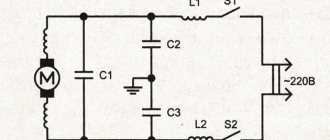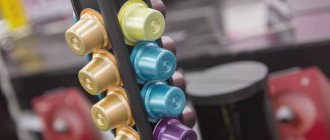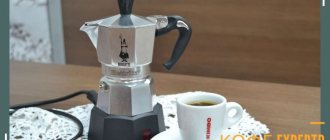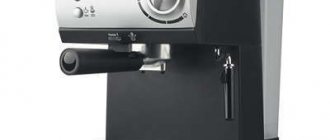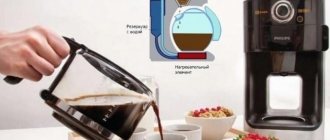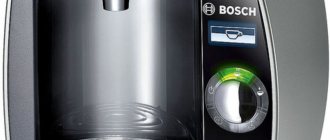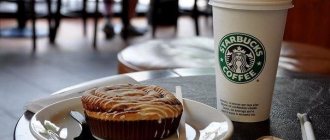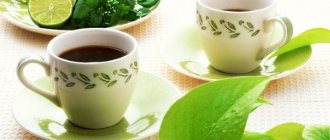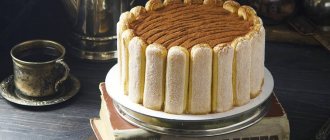Millions of people around the world start their morning with coffee. Some people like instant drinks, while others are comfortable using specialized vending machines or visiting a cozy coffee shop on the way to work. And there are those who prefer to cook it themselves from freshly ground grains. For these purposes, a coffee pot is traditionally used - a special utensil with a long handle and a narrow neck, made of forged copper. The choice of this product should be approached as responsibly as possible. Here, the material, shape, wall thickness, neck and bottom size, volume of the container are equally important - each of the listed parameters affects the taste of the prepared drink.
Design features
Turka, also known as cezve (the name comes from the Turkish word cezve), is a vessel with a wide bottom and a narrowed neck, equipped with a handle. The product was invented in the mid-16th century, becoming an improved alternative to such devices as the ibrik and dalla. The first is a metal or clay jug with rounded sides, a flattened bottom and a long, curved spout. The second dish is somewhat similar to ibrik, but it has a wider spout, and the material used is always metal.
Components of Turkish coffee:
- frame;
- bottom;
- extraction chamber;
- pen;
- neck;
- foam catcher.
Making Turkish coffee is very simple. The crushed grains are poured into a bowl and filled with water. As the drink heats up, a so-called coffee plug forms at the neck, which retains the aroma and helps preserve the taste of the drink. When boiling, the liquid with foam rises, and the foam collector prevents it from splashing out. Coffee prepared in this way retains 100% of its beneficial properties.
All the advantages of the Turk are due to its trapezoidal shape. The diameter of the bottom should be at least 2 times larger than the neck, otherwise valuable essential oils will quickly evaporate and the drink will lose its rich taste.
How to care
Not everyone knows that a product such as a Turk requires certain care. For each product, depending on the material of manufacture, there are certain care rules, compliance with which significantly extends the service life and improves the appearance.
- Copper and brass cezves are coated with food-grade tin, which is easily damaged and therefore requires gentle washing. The use of metal meshes and cleaning products containing abrasive particles is prohibited. Manufacturers do not recommend washing in the dishwasher; the product is washed by hand in running water. There may be streaks left on the Turk that has dried on its own, so it is better to wipe it with a towel, this will give it a characteristic shine.
Such products tend to darken over time, so the outside is periodically cleaned with special means or traditional methods.
Manufacturers do not recommend washing in the dishwasher; the product is washed by hand in running water.
- Aluminum and stainless steel products can be washed in the dishwasher and using abrasives.
Aluminum and stainless steel products can be washed in the dishwasher and using abrasives. - Glass and clay cezves do not require additional care or hand washing, but the process requires care due to their fragility.
A generalized answer to the question that interests many: “Which models are better for coffee?” – having traditional proportions, heating evenly, cooling slowly, durable.
The entire existing modern variety of products is still inferior to the copper Turk invented in ancient times, which is ahead of its analogues in many respects. Ceramic Turks are a good option, but unfortunately they are susceptible to the formation of microcracks.
For adherents of exclusively one preparation recipe, clay products are good; they absorb the aroma of the prepared coffee and saturate the subsequent brewed drinks with it.
For adherents of exclusively one preparation recipe, clay products are good; they absorb the aroma of the prepared coffee and saturate the subsequent brewed drinks with it. For people who have no experience in brewing coffee, the best option is a glass cezve; transparency allows you to learn to control the process.
Classification
The assortment of modern tableware includes many varieties of coffee pots. They are made from different materials, differ in thermal conductivity, features and duration of operation, and cost. In order for your purchase to meet all expectations, you need to understand the key advantages and disadvantages of common types.
By heating method
Depending on the characteristics of heating coffee, there are 4 main models of Turks.
| Types of Turks for making coffee | What is | Advantages | Flaws |
| Classical | A traditional trapezoidal product designed for brewing coffee on a gas stove or hot sand | Suitable for preparing coffee according to any recipe | The disadvantages directly depend on the material from which the Turk is made |
| Electric | Connects to the mains. Provides a larger volume than similar products and is equipped with various sensors and indicators | Requires minimal time to prepare a drink - from 30 to 60 seconds, takes up little space, easy to use | The appliance must be descaled regularly. The taste of the finished drink is inferior to coffee brewed in a classic Turk |
| For glass ceramics | A classic-shaped Turk made of ceramic, clay, glass or porcelain with a thick, flat bottom | The glass-ceramic stove heats up for a long time, which allows you to fully reveal the taste of coffee | A Turk that is not removed from the stove in a timely manner quickly becomes unusable. |
| For induction cooker | Such Turks are made of ferromagnetic alloys, mainly steel | A model purchased specifically for an induction panel can be used on other hobs | The bottom area of the Turk should cover at least 70% of the burner. An additional adapter is required for even heating |
A proper coffee pot must meet the basic requirements: wide bottom, narrow neck, material with high thermal conductivity. All other factors depend on the operating conditions of the product.
For induction cooker
For glass ceramics
Classical
Electric
By volume
The capacity of the dishes is an important criterion. To find out which Turk is better to buy, you need to decide on the number of people who will use it. The classic option is a 100 ml cezve. It will only be enough for one person, because when the liquid boils there should be room for the rising foam. Accordingly, 1–2 teaspoons of ground coffee are poured into 50–75 ml of water. For 2-3 family members, it is worth considering options for 350-500 ml. For more people, the 750 ml Turk will become indispensable.
The water level should be close to the neck of the product, so it is not recommended to brew one portion of coffee in a large Turk - this way the foam plug will not be dense or will not form at all.
By design
It is necessary to choose a coffee pot based on its shape, which affects the preparation process and the taste of the drink:
- Conical. With a wide bottom and tapering sides that hold most of the coffee grounds. The narrow neck ensures the formation of a plug, and the foam catcher prevents spillage. Usually made of copper, brass, aluminum.
- Cylindrical. Heats water unevenly. Due to prolonged exposure to high temperatures on the bottom layer, the usual taste of coffee changes. Turks of this shape are mainly made of steel.
- Barrel-shaped. The manufacturing material for such products is usually ceramics or clay - they maintain the temperature for a long time, providing a more pronounced taste of the drink. However, due to its high heat capacity, the foam may escape even if the ceramic coffee pot is removed from the stove in time.
The optimal wall thickness of a metal Turk is 1.5 mm. Only clay and ceramic products have greater value. Some manufacturers make only the bottom thick, which indicates the connection of the two parts. Such a design often indicates the fragility of the Turks, because due to regular temperature changes, the quality of the seam decreases.
Barrel-shaped
Conical
Cylindrical
LiveInternetLiveInternet
Author: Galina hand-made
Good afternoon, my dear craft lovers!
Today, I want to show how you can diversify such a direction in needlework as the “floating cup”. In addition to a floating cup with coffee, flowers and coins, you can make a floating Turk.
<<>>
In my previous work there was a floating cup with a mini cake (you can watch the master class here). Today, it will be a floating Turk.
My husband and I were invited to my friend's birthday party. And since she is a passionate lover of good coffee, I decided, in addition to the main gift, to make a steaming Turk. This is actually why this master class was born. So:
For work I needed:
- Coffee couple;
- Aluminum cup;
- Wire;
- Glue gun;
- Acrylic brown paint;
- Acrylic lacquer;
- Coffee beans.
I had this pair of coffees in stock, and I bought an inexpensive set of aluminum cups for the occasion in the store.
Coffee pair and aluminum cup
I asked my husband to make a handle for the Turk. Of course, if you wanted, you could come up with anything yourself. But I took the path of least resistance. Moreover, for him, this is not a problem. My husband has everything he needs to work with wood. This is the handle my darling made for the Turk. Moreover, at the same time, Lesha also made a gift - for my friend, a coffee lover. I made a pendant as a talisman for a car mirror. The work can be viewed here
Handle to the Turk
Then I sanded the handle, drilled the cup and screwed the handle to the cup with a small screw. It turned out to be a Turk.
Turka is ready
Of course, it was possible not to screw it, but to glue the handle, because... there is no load on the handle. But, in such matters, I prefer to trust a man. To screw it up means to screw it on! Sorry, I got distracted. That's it, the Turk is almost ready. If you wanted, you could decorate it, but to be honest, I was lazy.
In order for the Turk to float, of course, it must be attached to a wire. I took a single wire, because... Turk is light. I measured the length I needed and curved it on both sides. The top loop is for gluing the Turk. The bottom loop is for the cup.
I bent the wire at the top and bottom.
I placed the top loop on the Turk and, using a heated glue gun, applied glue inside the Turk. And immediately, before the glue cooled down, I threw in some coffee beans. Some of the grains were slightly submerged in the glue. I did this on purpose, it seems to me that it will look more natural.
Attention! Be careful with the glue gun! Take care of your fingers! Hot glue!
Glued the wire to the Turk
While the glue was cooling, I fixed the wire so that it would not move. After cooling completely, I glued the wire to the cup. I didn't apply much glue, just enough to secure it. And again I held the structure until the glue cooled.
When the entire structure was assembled, a napkin was glued to the wire (with regular glue).
Glue a napkin onto the wire.
Glue a napkin onto the wire.
The next process is to apply glue over the entire surface of the wire. I started with the inside of the Turk, and applied glue to those places where it seemed to me that it was missing.
Then, I applied glue to the wire in parts, from top to bottom. And immediately, while the glue was hot, I inserted coffee beans. I deliberately do not apply the coffee beans close to each other, but leave gaps. Later, after painting, areas of glue where there are no grains will imitate hot chocolate or coffee. I like it better this way.
When she reached the cup, she raised the level of “coffee poured into the cup.” And to save glue, I poured coffee beans into a cup and already filled them with glue. And she again scattered coffee beans over the surface.
Apply glue and coffee beans to the wire
After the glue cooled, I started painting. To do this, I mixed brown acrylic paint (color - burnt umber) with acrylic varnish. Acrylic paint itself is a bit thick for this process. Therefore, I diluted it with acrylic varnish, in a ratio of approximately 1:1 and added a little water.
We bring the paint to the desired state.
When I was happy with the consistency of the paint, I began to paint over all areas of the cooled glue with a thin brush. The work is painstaking and requires precision. But in principle there is nothing complicated. The only thing is that it’s a little difficult not to touch the Turk or the cup at the border with the glue. I painted over the excess a couple of times, but immediately cleaned it up. Then I adapted. It turned out like this
We paint the areas of the cooled glue.
And one more thing, when I applied the paint, I wasn’t afraid to “smudge” the coffee beans. On the contrary, in some places I did it deliberately; it seems to me that it looks more natural this way.
The composition is a floating Turk and a cup of coffee is almost ready. All that remains is to glue the cup to the saucer using the same glue gun. And you can admire your work!
By the way! Unlike the floating cup with a mini-cake, the floating Turk took me much less time and consumables.
Floating Turk and a cup of coffee
Floating Turk and a cup of coffee
https://mactera-rukodeliy.ru/dekor/paryashhaya-turka.html
Materials for making a cezve
It is impossible to draw a clear conclusion which coffee pot is the best. Different manufacturing materials have both advantages and disadvantages, which affects the quality of not only the product itself, but also the drink prepared in it. Taking into account all the nuances, every coffee lover will be able to choose the best option for themselves.
Clay
A clay coffee pot is the choice of real gourmets. The specific structure of the material provides a special, deep and rich taste of the drink. Heat here spreads slowly and persists for a long time. This option is ideal for hot sand. At the same time, the clay absorbs the aroma of coffee. Accordingly, the same Turk is not suitable for different types of grains. Among the disadvantages, it is also worth highlighting the fragility of the material and the high probability of foam running off in such dishes.
Ceramics
The properties of ceramics are somewhat similar to clay. Such a Turk also ensures maximum development of the taste of the drink, and due to its thick walls it retains its heat for a long time. However, the material does not absorb the smell of beans. Ceramic cookware can be used to work with different types of coffee. Such properties are equivalent to the characteristics of copper, so it is very difficult to say which Turk is better - ceramic or copper. The main disadvantage is low strength - even the best and most expensive ceramic model is easy to break, so it requires careful handling.
Steel
Owners of induction cookers should choose a stainless steel pot. The material has pronounced ferromagnetic properties necessary for safe contact with a modern hob. In addition, it is very durable, which distinguishes such products from analogues made from other alloys. But the steel Turk is not the best for those who have a delicate taste for coffee. Due to low thermal conductivity, the liquid is heated unevenly, which negatively affects the quality of the drink.
Aluminum
If we rank the best materials for Turks, aluminum will definitely take one of the leading positions. In terms of quality, it is inferior to copper or brass, if only because it looks extremely unpresentable. But its cost is significantly lower than other alloys, which means that every fan of an invigorating drink can afford to purchase such a Turk. Advantages of aluminum products:
- ease of care;
- immunity to mechanical damage;
- safety;
- light weight.
The thermal conductivity of aluminum is half that of copper. But this is enough to heat the liquid evenly, which is why the taste of coffee from aluminum Turks is not inferior to drinks brewed in other traditional cezves.
Silver
A silver Turk is an expensive and elegant product that can decorate a classic interior. Only jewelry factories and private workshops work with precious materials. External decorative characteristics are the main and, perhaps, the only advantage. A Turk made of silver is impractical in everyday life. It produces watery coffee due to excessively rapid heating. In addition, the cost of such products is very high; other types of Turks will cost much less.
Cupronickel
Despite the fairly high quality of the material, such Turks are very rarely found on sale - and this is the only thing that can upset a potential buyer. Cupronickel is nothing more than an alloy of copper and nickel, so all the advantages of such products are almost identical to copper ones. A special feature is slightly lower thermal conductivity. Cupronickel Turks of classic shape perfectly preserve the taste and aroma of coffee. And the principle of preparing a drink on the stove is no different from the traditional one.
Brass
A brass pot has more advantages than disadvantages. The main reasons why many buyers choose it:
- high strength;
- reasonable cost;
- no need for specific care;
- preservation of the taste and aroma of coffee;
- aesthetic appearance.
The brass Turk must have a protective coating that will prevent the oxidation process. If the latter occurs, the product becomes unsuitable for further use.
A good, high-quality Turk is usually coated with food-grade tin.
Copper
The copper Turk is an unchanging classic. This material has always been in demand due to its large number of positive properties. The high level of thermal conductivity allows you to quickly but evenly heat the liquid. The prepared coffee has a rich taste and aroma. If we consider which pot is better - copper or stainless steel, the first one will certainly win. Its only drawback may be the lack of internal coating, but such models have long been rare in the range of modern products.
Theory
Copper is one of the oldest metals, which is used by people to create various decorations, devices and communications. It is characterized by high plasticity and pinkish-red color, sometimes with a golden tint. In the household, copper is most often used in water pipes and heating, because it does not corrode and is resistant to temperature changes.
Photo - copper connections
There are many types of soldering; capillary soldering is used for copper. It allows you to connect two parts of a pipeline or radio components as accurately and firmly as possible. This thermal effect is also divided into:
High-temperature soldering is characterized by higher weld strength. In addition, it allows the connection to be thermally stable, which is very important for various communications. But at the same time, this type of work is not used on threaded connections. To carry out such soldering, special equipment is required - a burner with piezo ignition and acetyl, propane.
Photo - copper elements
Low temperature is used when working with soft solders (pastes, gels). The main advantage of this technique is the simplicity and ease of work. It is carried out at a temperature lower than 425 degrees, so soldering can even be done with a soldering iron. It lies in the fact that, under the influence of a certain temperature, the solder applied to the gap between the part and the area being connected expands, closing the gap.
Photo - soldering process
There is also one important rule that must not be violated under any circumstances. Soldering copper and aluminum, or aluminum and brass, is strictly prohibited. It is performed for electrical wires, for example, if you need to branch the wiring in old houses. This is prohibited due to the difference in linear thermal expansion of the metals and the likelihood of a short circuit at the joint.
The nuances of choosing a handle
Having figured out how to choose a Turk based on the type of material, you need to pay attention to the issue of selecting a handle. It should be as comfortable as possible, because during the process of brewing coffee the need for this detail arises repeatedly. In most Turks, the handle is slightly raised up, and sometimes located almost vertically.
All-metal models are not uncommon in copper, brass, and steel products. They are also made as a separate element from non-heating materials - thermoplastic, wood. Mounted in two ways:
- soldering;
- bolts.
The latter is more reliable, since the soldering breaks down over time. The handle can also be removable - plug-in or screw-on. When purchasing, you should pay attention to its location on the metal Turk. Too short a distance may cause burning.
If the choice fell on a ceramic Turk, you should give preference to cast and hollow handles.
Product design and style
A high-quality coffee pot should not only be practical to use, but also aesthetically attractive. The best design is considered to be the one that matches the existing interior in the kitchen. However, this requirement is optional. A coffee pot made in ethno style will definitely not be out of place on a stove built into a classic set. As for modern trends, it is better to give preference to metal, strict models. Regardless of the chosen style, you need to remember important nuances:
- Cezves in dark colors or with an aged effect retain their presentable appearance longer than others.
- A large number of applications and modeling makes it difficult to care for the product.
- Due to regular heating, the Turk will lose its applied decor over time; as an alternative, it is better to consider engraving or embossing.
For the rest, each person should rely on his own taste. A coffee pot is not a utensil where appearance is of paramount importance. Its main task is to prepare a delicious drink.
Which Turk is better?
Aluminum fool
Aluminum is a material with lower thermal conductivity than copper. For all that, aluminum is much cheaper. That is why it is considered more practical
: even if such a Turk bends, you don’t feel sorry for her; and it doesn’t cost anything to glue the product (that’s why the aluminum Turk is such a camping option).
What to do with the statement that an aluminum tureen is harmful to health?
Indeed: the acidic environment of some products reacts with aluminum, “absorbing” a certain amount of it
. However, coffee brewed in an aluminum pot, to put it mildly, is unprofitable and has nothing to do with an acidic environment.
And in general, let's dispel the legend about the dangers of aluminum cookware: it has been proven that even the most aggressive acidic biome (for example, a tomato in combination with lemon and vinegar
) removes such an amount of aluminum from cookware that is only 10 percent higher than the average daily dose of consumption of this metal.
Keep in mind!
The model of aluminum Turks, most often made by stamping, often differs from the classic-shaped
. Because of this, the aroma of coffee brewed in a Turkish tea pot is partially lost.
Aesthetically, the aluminum Turk also does not attract much attention. And for the entire century, a cezve made from such material has the right to live, since the coffee prepared in it has quite decent taste qualities
in order to avoid the average person. Moreover, such a Turk is so inexpensive that some things can be changed at least once a week.
Tips for choosing
To choose a really good Turk for brewing real coffee, you should consider a few tips:
- If the drink is intended for one person, there is no need to consider products with a volume of more than 100 ml.
- You can prepare coffee with a rich taste only in a classic cone-shaped Turk.
- The thinner the walls of the product, the faster the liquid will heat up, and the less quality the drink will be.
- For those who hardly know how to use a Turk and are looking for a universal option, copper, brass, and cupronickel models are suitable.
- True gourmets should pay attention to high quality ceramic or clay products.
- The more securely the handle is attached, the longer the cezve will last.
- The minimum number of decorative elements is the key to easy maintenance.
When buying a Turk, you also need to take into account the type of stove. Induction and glass-ceramic models require a special approach to the selection of cookware and household appliances.
A good coffee pot - what should it be like?
To determine which Turk is better, you need to know the characteristics of suitable coffee utensils. This is what a good Turk looks like.
- Cone shape.
- Thick bottom.
- The material used has good thermal conductivity.
- The ratio of neck and bottom is 1:2. The greater this difference, the tastier the coffee.
- Handle made of heat-insulating material.
- Convenient volume.
- Easy to use.
- Reliable to use.
Which Turks best fit this ideal portrait?
Terms of use
There are many freely available recipes and recommendations on how to properly brew Turkish coffee. Traditional method:
- Pour in coffee, add sugar if necessary, lightly fry the mixture, stirring constantly.
- Add water and leave the Turk over very low heat.
- After the foam has formed and risen to the edge, remove the cezve from the heat and let the foam settle.
- Put the dish back on the fire and repeat the same steps 3-4 more times.
When preparing coffee, the main thing is not to bring it to a boil, otherwise the drink will lose its proper taste and aroma.
At the end of the process, the Turk must be washed with warm water using a soft sponge without abrasive or detergent substances. There is no need to try to remove the formed film from coffee oils; it is enough to rid the dishes of the remaining grounds. Over time, carbon deposits form on the outside. Methods for removing it depend on the type of material it is made of; lemon, vinegar, and soda are universal means.
Which Turk is better?
What to choose for Turkish coffee
A turk (or, to put it correctly, a cezve) is a vessel of a specific shape in which, strictly speaking, this aromatic drink
. The drink prepared in Turk is constantly called Turkish coffee, and in many countries, including Russia and Europe.
Most of all, the Turk resembles a kind of ladle or jug with a long handle the size of a gulkin’s nose. In general, the name “Turk” is a kind of gag from the Russian people
. Initially, the dishes were called cezve, meanwhile the word “Turk” became more familiar to most domestic consumers.
This interesting vessel has several varieties that differ from each other in details, but use the same principle of making coffee
. So, one of the varieties of Turks is the Arab dhal, which is even more similar to a jug; in Armenia they use sdrzhep, which is more similar to the Turk we are used to.
What material are Turks made from?
The variety of materials for Turks is, in fact, considerable: you can find copper Turks on sale (this is the traditional material for such utensils
), aluminum, ceramics, brass, cupronickel, steel and various alloys, clay Turks, glass Turks and even silver cezves.
It would be a good idea to drink Turkish coffee of different materials - for some it may help to lighten their choice of cezve. But if you don't feel the difference
, this does not mean that you don’t have to bother choosing the material! This can also mean that the person who made you wonderful coffee in the worst Turkish coffee simply knows how to use it.
If you decide to treat yourself every day to coffee prepared on your own in a Turk, then you should pay attention not only to what material it is made from
it is made, but also to its shape. In fact, as you will see later, these parameters (shape and size of the Turkish coffee) are terribly important for preparing real Turkish coffee.
By the way!
Coffee brewed in Turk is not always what it is called (fragrant in Turkish or Oriental style! Coffee under this name is just one of the options for making coffee
in Turk, of which there are plenty. However, we’ll talk about recipes another time, but for now let’s return to the materials from which Turka is made.
